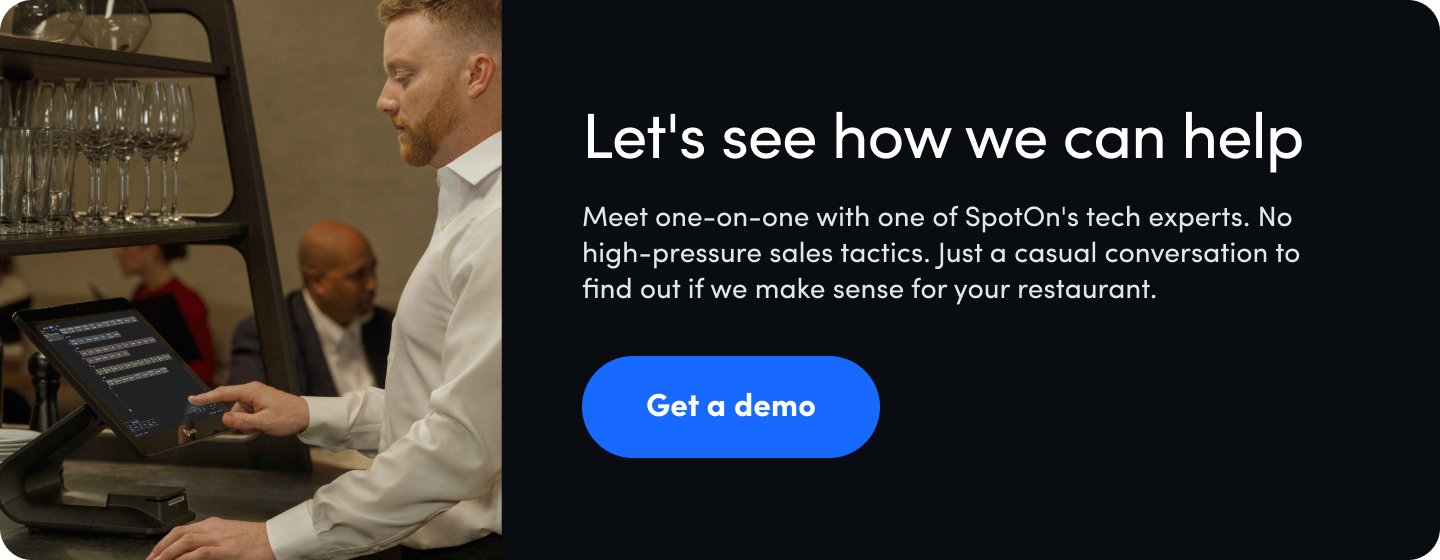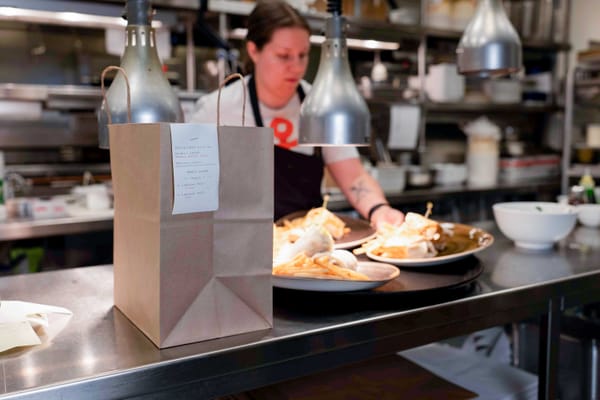Tip pooling is one of the most talked-about and often misunderstood compensation practices in the restaurant industry.
On the surface, it’s pretty straightforward: combine tips from tipped employees and redistribute them across the team.
In practice, however, it can spark staff resentment, open you up to legal risk, and complicate your payroll if it’s not done correctly.
As a restaurant operator, it’s your responsibility to create a fair system that keeps your teams happy while staying compliant with federal regulations and local laws.
Whether you're exploring a tip pooling system for the first time or refining an existing one, getting it right can make a meaningful difference in both team performance and employee retention.
In this article, you will learn:
- Why restaurants might want to use tip pooling
- The legal rules and risks tied to tip pooling laws
- How to implement a tip pooling system that’s fair and efficient
Let’s start with the basics of what tip pooling really means.
What is tip pooling
Tip pooling is a system where a restaurant collects all or a portion of the tips received by tipped employees and redistributes them among a broader group of staff.
How this is done can vary widely from restaurant to restaurant, but it’s meant to ensure that everyone who helps deliver the guest experience (this typically means everyone in the front-of-house, but sometimes includes back-of-house) receives a share of the total tips.
A common question is: What’s the difference between tip pooling and tip sharing?
Tip pooling
- Definition: All or most tips from a shift are collected into a central “pool” and then redistributed among eligible staff according to a set formula (often hours worked, points, or percentage).
- Key Difference: Everyone contributes their tips, and everyone gets a share back. It’s designed to spread tips more evenly across the team, sometimes including back-of-house if local/state law allows.
Tip sharing
- Definition: Also known as tipping out, servers keep the bulk of their tips but are required to give a portion to support staff like bussers, bartenders, or food runners. Bartenders also have to tip share when they have a barback or busser. Tip sharing has been a standard practice in the U.S. for decades, starting long before today’s tip pooling systems were introduced.
- Key Difference: The redistribution is partial, not total. The server decides (or the restaurant sets) what percentage is shared, but most tips stay with the person who earned them.

Understanding the difference between a tip pooling policy and a tip sharing arrangement is important because the two are regulated differently under federal law and local law (more on that in a minute).
Let’s look at why operators might choose to implement tip pooling in their business.
Why restaurants use a tip pool
For many operators, the biggest draw of a tip pooling system is fairness and the chance to improve team culture in their restaurant. While it might not work for every restaurant, tip pooling works incredibly well for concepts like:
- Quick service restaurants (QSR)
- Counter service
- Coffee shops
- Cafes
- Fast casual
These types of restaurants are more team-oriented, meaning everyone shares an equal role in delivering the guest experience.
In these situations, a tip pooling policy ensures that tips collected don’t depend on who happened to ring up the customer but are evenly distributed among eligible employees who keep service running smoothly.
The three main reasons restaurant owners adopt tip pooling arrangements are:
1. Reduce conflicts and create fairness
Left unchecked, tips earned can differ significantly depending on section assignments, when shifts start, or just sheer luck. A traditional tip pool helps keep things balanced, cutting down on resentment and avoidable conflicts between team members, making sure the whole team feels valued.
2. Improve teamwork and service culture
When staff know that tips received will be shared according to fair and transparent guidelines, whether by hours worked or a point system, they’re more likely to help each other out.
Everyone does their part, running food, bussing tables, and taking orders because the entire team’s success is tied together.
3. Boost retention in a competitive labor market
Keeping good employees is a constant struggle in the hospitality industry—tip pooling gives valuable workers the stability and predictability they need to budget and plan a more comfortable life outside of work.
These benefits reduce turnover and help operators keep more experienced teams in place.
Tip pooling laws you need to know
If you’re considering implementing tip pooling at your restaurant, it’s essential that you first understand the laws and regulations surrounding it. Ignoring them could land you serious legal hot water if not structured correctly.
Here is a summary of what the Fair Labor Standards Act (FLSA) says about tip pooling at the federal level:
Managers and supervisors cannot participate
Under federal regulations, they’re prohibited from keeping tips or taking part in any kind of pool. If they do, it may be considered a form of tip theft, which carries serious legal consequences.
Employers must provide notice
If your business requires a mandatory tip pool, you must give staff clear oral or written notice of your tip pooling policy so there’s no confusion about how tips collected are being redistributed.
Back-of-house participation depends on wages
A tip credit allows an operator to pay a lower cash wage (as little as $2.13 under federal law) as long as the employee’s tips received make up the difference to the federal minimum wage ($7.25).
If you use a tip credit, only front-of-house staff who customarily and regularly receive tips (like servers, bussers, and bartenders) can be part of the pool.
But if the employer pays the full minimum wage in cash, then non-tipped employees such as cooks or dishwashers can also legally share in the pooled tips.
Limits on non-tipped work
The FLSA also enforces what’s called the 80/20 tip rule. This rule says that if you’re taking a tip credit, your tipped employees can’t spend more than 20% of their shift on tasks that don’t directly generate tips (like rolling silverware or prepping side stations).
If they go over that limit, the employer pays the difference by raising their wage to the full minimum wage for that time.
What about local laws?
Beyond federal rules, local laws vary from state to state, with some being stricter than others. For example, states like California prohibit the use of tip credits altogether, which changes who can be included and how tips collected must be distributed.
With so many layers of regulation, mistakes can lead to expensive penalties, so take the time to train managers carefully to ensure that tips collected are always handled by the book.
Do most restaurants pool tips?
The short answer is: it depends.
As we talked about earlier, tip pooling can be a better fit for some concepts more than others.

- Quick-service and fast casual restaurants: Because service is highly team-oriented, tip pooling work is significantly more common. Everyone contributes to the guest experience—from the person running the till to the food runner—which makes tip pooling feel fairer.
- Casual dining: Adoption is mixed, and it really depends on the restaurant. Some operators stick to tip sharing (servers “tip out” bartenders, bussers, and hosts), while others prefer tip pooling with the entire team.
- Fine dining: Here, tip sharing is more common than tip pooling. Servers often keep the bulk of their tips earned because they were the “face” and coordinator of the dining experience, tipping out support staff at the end of their shift.
A 2022 survey found that 43.8% of participants reported that the restaurant where they worked used tip pooling—this number is likely to have increased as operators seek ways to reduce turnover, improve teamwork, and provide steadier incomes.
Rising wages and ongoing labor shortages have also pushed many restaurants to experiment with new pay models that benefit employees while keeping payroll costs manageable.
That said, not every business operates this way.
For example, in restaurants where servers have significant influence over their tip amounts (like high-end dining), management often avoids tip pooling to protect servers’ ability to earn a higher tip based on their own performance.
This is an employee retention strategy because these servers and bartenders have an appreciably higher skill set than most restaurant workers and want to be compensated accordingly.
How to set up a tip pool in your restaurant
Once you’ve decided that tip pooling makes sense for your restaurant concept, the next step is putting a clear structure in place and making it official.
The goal is to design a tip pooling policy that is transparent, compliant, and feels fair to your team.
1. Put it all in writing
Federal law requires that any mandatory tip pool include an oral or written notice—but to set expectations, it’s best just to print it out and post it somewhere in the back of the restaurant where everyone can see (if you have one, the employee bathroom is a great spot). If you have an employee handbook, be sure to include it there too.
Spell out how total tips will be handled, whether they’ll be evenly distributed, divided by hours worked, or allocated through a points system that assigns value to each role.
2. Communicate clearly with staff

When changing how tips earned are distributed, staff buy-in is critical because you don’t want unhappy workers spreading dissent amongst your team.
Explain how the system will benefit employees, why you chose the method for distributing tips, and how you’ll transparently calculate each person’s share.
For example, a cafe might base tip splitting on hours worked, while a casual restaurant could use total points that reflect the weight and skill set of each position.
3. Train managers for consistency
Train managers to clearly understand tip pool laws, regulations, and your in-house policies, so if there are any discrepancies or situations that fall into a gray area, they’ll know what to do.
For example, what happens if a server underreports cash tips, or if a tipped employee leaves in the middle of their shift?
Clear answers prevent conflicts before they escalate. It’s also smart to cover your tip pooling policy during onboarding so new staff understand how employees' tips will be shared from day one.
4. Monitor and adjust if necessary
Don’t feel like the first version of your tip pooling policy is locked in stone. After a few pay periods, look at the numbers and ask your staff how it’s working.
Is the formula fair?
Is it helping retain staff?
Gathering feedback and adjusting, whether that’s tweaking the points system or changing how employee tips are divided, will help you find the right balance for your team.
How technology streamlines tip pooling
Managing a tip pool manually can get messy fast—spreadsheets, time clocks, and scrap paper full of calculations are not only time-consuming, they’re also prone to mistakes. Small errors in distributing tips can add up to big trust issues with your staff.
Even when the math is right, the lack of transparency can leave employees questioning whether employee tips are being handled fairly.
That’s why more restaurants are moving away from spreadsheets and adopting tip management software.
How software ensures accuracy and transparency
Using tip management software, operators can decide how they distribute tips, meaning by role, hours, or a points system, and the platform does the math for them instantly.
Employees can see the tip breakdowns for themselves, removing any doubts or suspicions, reassuring them that everything is correct and fair. Transparency alone can go a long way toward strengthening team morale.
Benefits for operators
Here are a few ways operators can see immediate advantages when using a tip management solution:
- It integrates with payroll: Managers no longer have to tally up cash and credit card tips when wrapping up at the end of the day. The software tracks everything automatically and sends it straight to payroll, which saves management time and headaches. It also shaves off labor costs because tipped employees no longer wait on the clock while you count out tips.
- Knowing you’re 100% compliant: Tip laws aren’t exactly light reading, and memorizing the dry tone of government labor documents is tedious. Using the right tipping software ensures your tip pool only includes eligible employees, keeps your numbers straight, and generates records in case there’s a dispute and you need to back-track tip distribution step-by-step.
- You’ll have happier, more loyal employees: Even if you’ve always managed tips fairly, eventually, someone’s going to feel like they got shorted. With tip management software, it’s easy to give staff full transparency so they’re never left wondering if they got their fair share. Tips are distributed faster and more accurately than any manual system, which means happier employees who stay with your business longer.
Set your team up for success with better tip management
The last thing you want is staff stressing about their tips. Before making the jump to a tip pooling system, talk with your team to understand their perspective on what feels fair.
Even if not everyone agrees at first, a reliable tip management system eases concerns and reassures staff that tips are distributed fairly and accurately—helping you build a team that’s happier and stays longer.
Frequently asked questions about tip pooling
Looking for quick answers to the most commonly asked questions about tip pooling in restaurants? Here are several frequently asked questions.
What is tip pooling, and how does it work?
Tip pooling is when tips collected during a shift are combined into a single pool and redistributed among eligible employees based on a formula—such as hours worked, a points system, or role. This ensures that the team members who support service, like bussers or food runners, receive part of the total tips.
Is tip pooling legal in every state?
Under federal law and the Fair Labor Standards Act, a mandatory tip pool is legal if it only includes staff who customarily and regularly receive tips.
However, states often add their own rules. Some ban the use of a tip credit, while others regulate whether non-tipped employees can take part.
Operators must follow the stricter standard when local laws differ from federal rules.
What is the difference between tip pooling and tip sharing?
In tip pooling, everyone contributes their tips to a central pool, and everyone gets a portion back.
In tip sharing (sometimes called tipping out), servers keep most of their tips but share a percentage with support staff like bussers or bartenders.
Can managers or supervisors participate in a tip pool?
No. Federal regulations prohibit managers and supervisors from keeping tips or receiving any portion of pooled tips, even if they spend part of a shift directly serving guests.
Only frontline staff who are legally considered tipped employees can be part of the pool.
Do most restaurants pool tips today?
It depends on the concept and how the restaurant operates.
Quick-service and counter-service restaurants often use tip pooling systems because everyone contributes to the same workflow.
Full-service and fine dining typically rely more on tip sharing, where servers keep most of their earnings but tip out support staff.
Understanding where your business fits on that spectrum helps you choose a structure that aligns with both your service model and compliance requirements.

DISCLAIMER: Everything here is just for informational purposes. The links and graphics may not be accurate and we encourage you to do your own research. Also, we can't guarantee results from following our advice. Always consult a professional for your specific situation.











